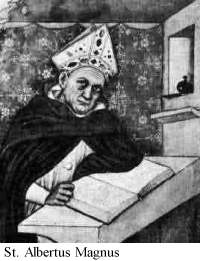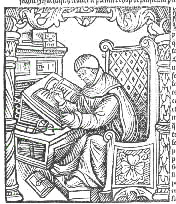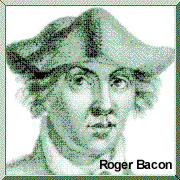The End of Europe's Middle Ages Intellectual Life
Europe entered the late Middle Ages firm in the conviction that all nations were part of the greater state of Christendom and all mankind were brothers within the fold of the Holy Roman Church. The Church defined and explained the universe and stood at the centre of intellectual and theological thought and Ideas were endorsed or condemned according to their ability to merge with established doctrines. The quest for a degree in theology remained the ultimate aspiration for students at Europe's cathedral universities and only the brightest dared hope to achieve the revered designation. Given these conditions, it is hardly surprising to find that the most brilliant and influential thinkers of the time emerged from the ranks of theologians and educators that developed within the shelter of the Church.
By the end of the Middle Ages, increased educational opportunities became available in response to the increased demand from commercial and social interests and the number of universities increased as towns expressed political independence through the founding of these institutions. Although the increased number of universities tended to localize institutional focus, the curriculum remained consistent, utilizing many of the same texts that had been used throughout earlier centuries.
Perhaps the single most critical intellectual issue of the later Middle Ages was the attempt to reconcile reason and religious faith. According to Christian doctrine, divine revelation was the only method of acquiring true knowledge. Tertullian(155-230) was representative of many early Church fathers when he declared that the study of philosophy and the natural world should be avoided because it distracted the mind from contemplation of the divine. One the few early Christian proponents of natural philosophy, Augustine(354-430) valued the classical education of his youth and took a more neutral approach. Augustine believed that, because God created nature, the study of nature was actually the study of God through His works.
 |
Tertullian | |
 |
"On Christine Doctrine" - Augustine |
Medieval scholars and theologians wavered between these two perspectives throughout the Middle Ages. The works of pagan philosophers continued to be taught despite their non-Christian origins for two main reasons: firstly, ancient knowledge was highly valued and, secondly, these works addressed many of the questions about how the universe operated. Aristotle(384-322 BCE) was considered the great authority and his surviving works formed the basis for many of the subjects in the medieval university curriculum. Nevertheless, serious conflicts between the cosmologiesof classical philosophy and medieval theology continued to exist and draw the attentions of medieval scholars. For example, although Aristotle's well-developed theories on the nature of the universe were taught across Europe, the fact that he emphasized observation and reason over revelation was a major problem. Many of Aristotle's propositions were in direct opposition to the existence of the monotheistic religion of an omnipotent deity.
 |
Aristotelianism |
A teacher at the University of Paris in the 1240's,
Roger Bacon (c. 1220-1292)
tried to prove that Aristotle was not a threat to Christian doctrine by demonstrating that Aristotelian theories could be used to prove faith and to convince non-believers of the validity of Christianity. Another theologian,
Albert Magnus (1200-1280),
 tried to "Christianize" Aristotle by replacing Aristotle's atheism with
Plato's (427-348 BCE)
demiurge. In the 13th century, a student of Albert Magnus and a colleague of Roger Bacon,
Thomas Aquinas (c. 1224-1274) built on their ideas. Aquinas' great works,
Summa contra Gentilesand
Summa Theologica (unfinished at his death), attempted to finally resolve the conflict between reason and faith. Aquinas allowed Aristotle's ideas that truth can be found in the original cause and that reason is required to search for the original cause. Aquinas then argued that, because God created all things, God is the cause of all things and therefore God is truth. Thus, the search for truth using reason is still the search for God. Furthermore, because reason and revelation are both given to man by God, they can never by in conflict.
tried to "Christianize" Aristotle by replacing Aristotle's atheism with
Plato's (427-348 BCE)
demiurge. In the 13th century, a student of Albert Magnus and a colleague of Roger Bacon,
Thomas Aquinas (c. 1224-1274) built on their ideas. Aquinas' great works,
Summa contra Gentilesand
Summa Theologica (unfinished at his death), attempted to finally resolve the conflict between reason and faith. Aquinas allowed Aristotle's ideas that truth can be found in the original cause and that reason is required to search for the original cause. Aquinas then argued that, because God created all things, God is the cause of all things and therefore God is truth. Thus, the search for truth using reason is still the search for God. Furthermore, because reason and revelation are both given to man by God, they can never by in conflict.
 |
Thomas Aquinas |
Unfortunately, many teachers, especially in Paris, believed that these arguments provided the freedom to teach Aristotelian theory without regard for theological implications. This situation was not appreciated by the Church. Finally, after numerous warnings, the Bishop of Paris issued the condemnations of 1277, prohibiting the teaching of 219 Aristotelian propositions that denied the omnipotence of God. Unfortunately, the question on the nature of the universe remained and the repression of Aristotle's theories opened the door to new ideas and philosophies.
Islamic expansions resulted in the recovery of texts that had been lost to Latin scholars for centuries but kept alive in Greek and Arabic translations. Especially influential were works by Plato. Although several of Plato's writings were known throughout the Middle Ages, several newly recovered works were translated into Latin in the fifteenth century. These writings presented a previously unknown aspect of Plato to Europeans of the day and Platonic emphasis on spirituality and the immortality of the soul fit well with the increasing awareness of individuality of piety and faith. The mystical Neo-Platonism that developed in the late Middle Ages and blossomed in the Renaissance was a continuation of the attempts by theologians to blend religion and philosophy. The major boost to the spread of Neo-Platonism was the founding of the Platonic Academy of Florence by Cosimo de Medici. The Academy was actually a loose network of people that read and studied Plato, engaged in informal discussions and occasionally gave public speeches. Formal instruction was provided by the most illustrious Platonic scholar of the time, Marsilio Ficino. Under Medici patronage, Ficino devoted his life to translating and studying Plato. His work, Theologica Platonica, influenced philosophers across Europe.
The same atmosphere that encouraged the re-emergence of Neoplatonism also allowed the development of a mystical philosophy called hermeticism. Amongst the mass of Greek and Arabic texts that flooded into western Europe in the fifteenth century was a twelve volume collection that had supposedly been written by an ancient Egyptian, Hermes Trismegister, who was believed to be a contemporary of Moses. Once the Hermetic Writings had been translated by Ficino, they provided the basis for a magical system of beliefs that sought to understand God and the secrets of the universe by using alchemy, ciphers, numerology and astrology. The mystical aspect of hermeticism blended well with the spiritual awareness of Neoplatonism, both philosophies pursuing knowledge of God and the universe by ethereal means. Although philological evidence disproved the authenticity of the Hermetic Writings in the seventeenth century, hermetic principles continued to occupy some of the greatest scientific minds well into the early modern period. Despite the mystical and magical connotations, the work of hermeticists and alchemists set the stage for the rise of modern science and developed much of the apparatus and many of the techniques used in laboratories today.
 |
Hermeticism |
 |
Return to Literature | Proceed to Visual Arts |  |
The End of Europe's Middle Ages / Applied History Research Group / University of Calgary
Copyright © 1997, The Applied History Research Group

